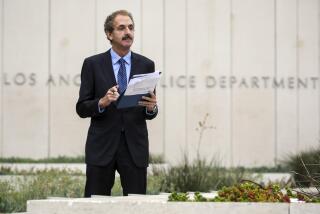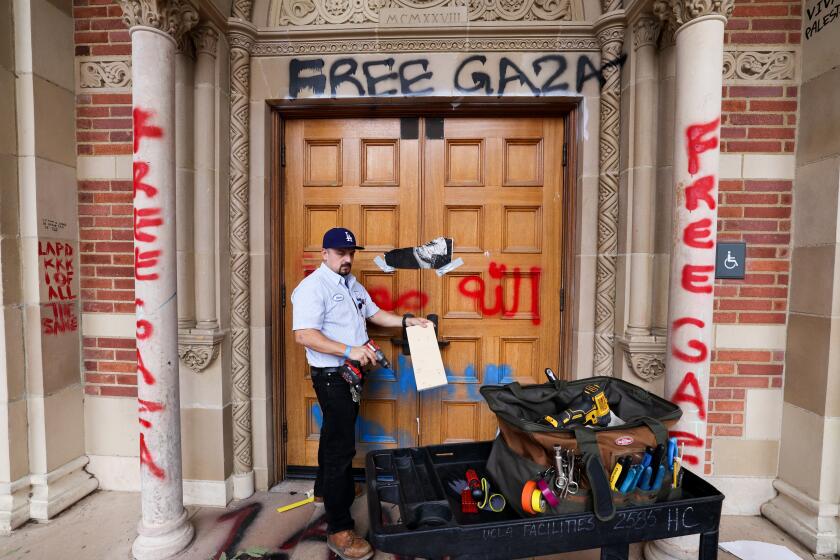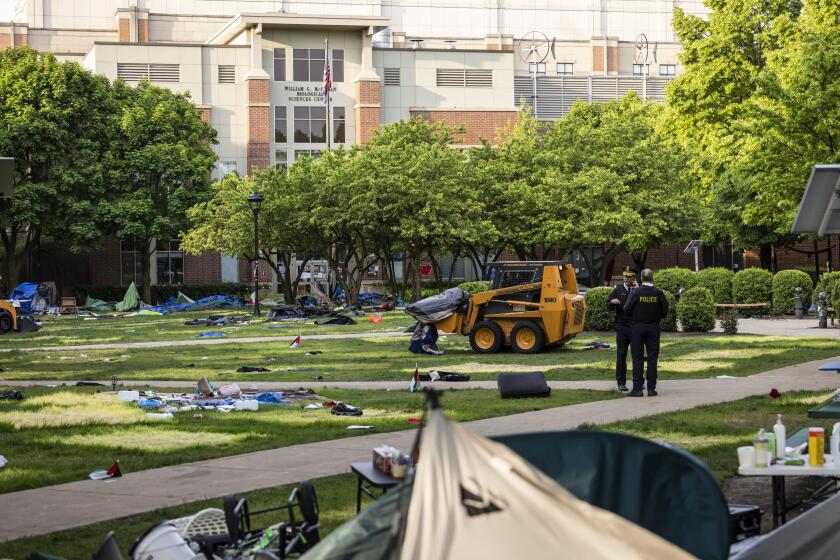Records on Asbestos Still Inadequate in Some Schools
A spot check of city schools in the San Fernando Valley has turned up widespread record-keeping violations of school asbestos rules, contrary to assertions by the school district to the U.S. Environmental Protection Agency that Los Angeles schools are in compliance.
Federal regulations require schools to have detailed, readily accessible information about asbestos in their buildings, yet many of the 23 Valley schools checked by The Times were missing some or all of the data.
The Los Angeles Unified School District was cited by the EPA in 1984 and again in September for violating the asbestos regulations--essentially “right to know” rules requiring that information about asbestos hazards in schools be made available to employees, parents and the general public.
After the September citations, the district filed formal statements with the EPA certifying that violations at specific schools visited by EPA inspectors had all been corrected.
The certifications, signed by Supt. Harry Handler, further stated that the district “has, to the best of my knowledge, complied with all other requirements” of the federal rules, which apply to all 800 of the district’s schools and other buildings.
Violations Common
But The Times’ review of records at schools not visited by EPA inspectors showed that violations of the asbestos rules still are common.
Asbestos is widely regarded by experts as the second-leading known cause of lung cancer (behind cigarettes) and has also been linked to other cancers and to asbestosis--a breathing ailment caused by repeated scarring of the lungs by asbestos fibers.
Under the federal rules, each school must have and make available to anyone a file containing a record of when the school was inspected for damaged asbestos and the locations where it was found.
Of the 23 Valley schools--which were visited during the past three weeks--9 did not have, or could not produce, a school asbestos file.
Three schools had asbestos files containing general information about asbestos health risks but nothing about conditions in those schools.
Files at several schools described the location of damaged asbestos in vague terms--contrary to federal requirements that the locations be clearly described in writing or by drawings or maps. For example, one report noted there was asbestos insulation in “Building L” without specifying where.
‘Surprised and Disappointed’
David Koch, acting business manager for the district, said he was “surprised and disappointed” when told of these findings.
But Jo Anne Semones, regional asbestos coordinator for the EPA in San Francisco, said she was not surprised because the results were “very typical of what our inspectors have found” in the two previous audits.
“The purpose of having this kind of information available in a school . . . is so that it is indeed accessible to anyone who wants to know about it,” Semones said.
Concerning the certifications signed by Handler and filed with EPA, Handler’s special assistant, Bill Rivera, said the superintendent meant that “we had fixed the violations that they had notified us of.”
Assumption Made
As for the assertion that all rule requirements had been met, Rivera said, “We have to assume that when administrators are directed to take certain actions, they will take them. . . .
“That’s why it says ‘to the best of my knowledge,’ ” Rivera said.
Semones of the EPA said there should be no confusion about the meaning of the signed certifications, which are “supposed to be an indicator to us that they have taken the effort to bring all of their school buildings into compliance.”
A brittle mineral widely used in insulation and other building materials, asbestos is perfectly harmless when intact. But when asbestos material becomes “friable”--broken or frayed--and is bumped or stirred by air currents, it can release microscopic fibers to the air.
Asbestos illness has shown up mainly in heavily exposed workers. But reports of disease in lightly or briefly exposed persons have led many experts to conclude that there is no safe exposure level.
Medical screening in 1983-84 of school district plumbers, custodians and others exposed to asbestos turned up 47 cases of asbestos-related disease among those who had been with the district at least 10 years.
According to the data, compiled by Barlow Occupational Health Center, 25 of the 47 employees had no occupational exposure to asbestos before going to work for the Los Angeles district. Workers considered to have asbestos-related disease were those whose X-rays turned up evidence of lung scarring.
Federal regulations gave public and private school districts until June, 1983, to inspect all of their buildings for friable asbestos and record and map locations where it was found. School employees and parent-teacher associations were to be notified in writing about the inspection results, and the information was to be kept in public files in school offices. Maintenance workers were to be advised to avoid disturbing material containing asbestos.
The rules were meant to stimulate asbestos removal, although it was left up to local districts whether to take corrective action. Under legislation passed by Congress and signed into law earlier this fall, school districts will have to begin correcting asbestos hazards by 1989, under guidelines to be issued by the EPA next year.
$6 Million Spent
Los Angeles school officials say the district in recent years has spent more than $6 million on asbestos projects in nearly half of their schools and have budgeted another $1.75 million for more work this year.
The district tries to correct asbestos hazards “as opposed to just sticking up a warning sign, which is all we’re required to do,” remarked Margaret Scholl, maintenance director for the district.
“That is why we say we’ve gone beyond the requirements,” she said.
Although substantial amounts of asbestos remain, district officials say it is largely confined to attics, crawl spaces and similar areas that are not accessible to pupils and teachers.
That is why Suzy Wong, principal safety officer for the district’s employee-safety section, said she believes the asbestos hazard in district schools is probably less than in many homes and hospitals.
According to the September EPA citations, the district’s inspection of buildings at some schools had overlooked friable asbestos. Several schools visited by EPA inspectors had no files on the asbestos, and in many cases there was no evidence that schools had supplied required information to employees and PTAs.
In the recent spot check of Valley schools by The Times, schools that had no asbestos files included Christopher Columbus Jr. High, Limerick Avenue, Fernangeles, Kester Avenue, Topeka Drive and Kittridge Street schools. Schools with files that contained no inspection results included Fullbright Avenue, Canterbury Avenue and Sunny Brae Avenue schools.
Inspection reports filed at some of the other Valley schools checked by The Times did not indicate the previous, or continued, presence of asbestos in areas of those schools where asbestos has been removed or encapsulated recently.
However, district officials said the omissions do not necessarily mean these areas were overlooked when the district inspected its buildings for friable asbestos in 1982 and ’83.
Official Explanation
They said many removal projects involved asbestos that became friable after the inspection was done. In other cases, they said, non-friable asbestos has been removed because it is in the way of a larger repair or remodeling project.
District officials said they intend to redistribute asbestos inspection reports, notification letters and other required documents to district schools, and to require each principal to certify in writing that his or her school is in compliance.
Non-compliance with asbestos regulations is punishable by monetary fines, although the agency has been reluctant to extract money in penalties that could have been spent on removing asbestos. The EPA did not seek financial penalties against the district for noncompliance in the 1984 case. It was not known whether agency officials will seek penalties this time.
More to Read
Start your day right
Sign up for Essential California for news, features and recommendations from the L.A. Times and beyond in your inbox six days a week.
You may occasionally receive promotional content from the Los Angeles Times.






